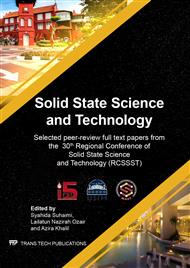[1]
Callister Jr, W. D. (2007). Materials Science and Engineering, 7th Edition, John Wiley & Sons Inc., USA.
Google Scholar
[2]
Dahaltu, S. A., Hussin, R., & Deraman, K. (2016). Structural Characterization of Sulfoborate Glasses Containing Magnesium Oxide. Jurnal Teknologi, 78(6-11), 73-76.
DOI: 10.11113/jt.v78.9200
Google Scholar
[3]
Kamitsos, E. I., Karakassides, M. A., & Chryssikos, G. D. (1986). Far-infrared spectra of magnesium-sodium-borate glasses. Solid State Communications, 60(11), 885-888. doi:https://doi.org/10.1016/0038-1098(86)90829-X.
DOI: 10.1016/0038-1098(86)90829-x
Google Scholar
[4]
S. Sen, Temperature Induced Structural Changes and Transport Mechanisms in Borate, Borosilicate and Boroaluminate Liquids: High-Resolution and High-Temperature NMR Results,, J. Non-Cryst. Solids, 253 [1] 84–94 (1999).
DOI: 10.1016/s0022-3093(99)00346-4
Google Scholar
[5]
J. Wu, M. Potuzak, and J. F. Stebbins, High-Temperature in Situ NMR Study of Network Dynamics in Boron-Containing Glass-Forming Liquids,, J. Non-Cryst. Solids, 357 [24] 3944–3951 (2011).
DOI: 10.1016/j.jnoncrysol.2011.08.013
Google Scholar
[6]
M. N. Svenson, et al., Composition-Structure-Property Relations of Compressed Borosilicate Glasses,, Phys. Rev. Appl., 2 [2] 24006 (2014).
Google Scholar
[7]
Siva Priya Jaccani and Liping Huang, (2016), Understanding Sodium Borate Glasses and Melts from Their Elastic Response to Temperature, International Journal of Applied Glass Science, 7 [4] 452–463.
DOI: 10.1111/ijag.12250
Google Scholar
[8]
J. Singh1, D. Singh, S.P. Singh, G.S. Mudahar, K.S. Thind, OPTICAL CHARACTERIZATION OF SODIUM BORATE GLASSES WITH DIFFERENT GLASS MODIFIERS, Materials Physics and Mechanics 19 (2014) 9-15.
Google Scholar
[9]
Dawaud, R. S. E. S., Hashim, S., Alajerami, Y. S. M., Mhareb, M. H. A., & Tamchek, N. (2014). Optical and structural properties of lithium sodium borate glasses doped Dy3+ ions. Journal of Molecular Structure, 1075, 113-117. doi:https://doi.org/10.1016/j.molstruc.2014.06.032.
DOI: 10.1016/j.molstruc.2014.06.032
Google Scholar
[10]
Hegde, V., Viswanath, C. S. D., Upadhyaya, V., Mahato, K. K., & Kamath, S. D. (2017). Red light emission from europium doped zinc sodium bismuth borate glasses. Physica B: Condensed Matter, 527, 35-43. doi:https://doi.org/10.1016/j.physb.2017.09.113.
DOI: 10.1016/j.physb.2017.09.113
Google Scholar
[11]
Seshadri, M., Radha, M., Rajesh, D., Barbosa, L. C., Cordeiro, C. M. B., & Ratnakaram, Y. C. (2015). Effect of ZnO on spectroscopic properties of Sm3+ doped zinc phosphate glasses. Physica B: Condensed Matter, 459, 79-87. doi:https://doi.org/10.1016/j.physb.2014.11.016.
DOI: 10.1016/j.physb.2014.11.016
Google Scholar
[12]
Pawar, P. P., Munishwar, S. R., & Gedam, R. S. (2016). Physical and optical properties of Dy3+/Pr3+ Co-doped lithium borate glasses for W-LED. Journal of Alloys and Compounds, 660, 347-355. doi:https://doi.org/10.1016/j.jallcom.2015.11.087.
DOI: 10.1016/j.jallcom.2015.11.087
Google Scholar
[13]
Wong, P. S., Wan, M. H., Hussin, R., Lintang, H. O., & S., E. (2014). Structural and luminescence studies of europium ions in lithium aluminium borophosphate glasses Journal of Rare Earths, 32(7), 585.
DOI: 10.1016/s1002-0721(14)60112-5
Google Scholar
[14]
Mohan, S., Kaur, S., Singh, D. P., & Kaur, P. (2017). Structural and luminescence properties of samarium doped lead alumino borate glasses. Optical Materials, 73, 223-233. doi:https://doi.org/10.1016/j.optmat.2017.08.015.
DOI: 10.1016/j.optmat.2017.08.015
Google Scholar


